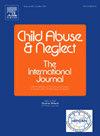西班牙性少数群体青少年受害和多重受害的普遍程度
IF 3.4
2区 心理学
Q1 FAMILY STUDIES
引用次数: 0
摘要
性少数群体的青少年特别容易受到伤害和多重伤害。目的本研究旨在调查过去一年西班牙性少数群体中学生受害和多重受害的流行情况,并分析基于性别和种族的差异。在4024名青少年(M = 15.52, SD = 0.99)的样本中,13.9% (n = 559)的参与者自认为属于性少数群体(即女同性恋、男同性恋、双性恋或其他(LGB))。性别分布表明,23.3%的参与者自认为是男孩,66.7%的参与者自认为是女孩,4.8%的参与者不认同性别认同,5.2%的参与者不愿意回应。大多数参与者认为自己是欧洲人(81.4%),而18.6%的人认为自己是少数民族。方法采用改编版《青少年受害问卷》(JVQ),增加了性剥削和网络受害的问题。结果74.1%的LGB青少年报告至少经历过一种形式的受害。43.5%的参与者报告了护工受害,42.9%的参与者报告了电子受害。观察到性别差异,被认定为不符合标准的个体报告的患病率明显很高。种族差异也被发现,少数民族在几次受害经历中报告的患病率更高。平均受害人数为4.6 (SD = 3.7)。总体而言,32.4%的年轻人被归类为多重受害者。鉴于LGB青年中受害和多重受害的高发生率,以及与性别和少数民族的交叉,研究结果强调了针对这一群体的独特需求和脆弱性制定预防方案的重要性。本文章由计算机程序翻译,如有差异,请以英文原文为准。
The prevalence of victimization and polyvictimization in sexual minority adolescents in Spain
Background
Sexual minority youth are particularly vulnerable to victimization and polyvictimization.
Objective
This study aimed to investigate the prevalence of victimization and polyvictimization over the past year among secondary school students in Spain who identify as sexual minorities, and analyze differences based on gender and ethnicity.
Participants and setting
In a sample of 4024 adolescents (M = 15.52, SD = 0.99), 13.9 % (n = 559) of participants self-identified as belonging to a sexual minority (i.e., lesbian, gay, bisexual, or other (LGB)). The gender distribution indicated that 23.3 % of participants self-identified as boys, 66.7 % as girls, 4.8 % as having non-conforming gender identities, and 5.2 % preferred not to respond. Most participants identified as European ethnicity (81.4 %), while 18.6 % identified as minority ethnic groups.
Methods
An adapted version of the Juvenile Victimization Questionnaire (JVQ) was used incorporating additional questions on sexual exploitation and online victimization.
Results
74.1 % of LGB youth reported experiencing at least one form of victimization. Caregiver victimization was reported by 43.5 % and electronic victimization by 42.9 % of participants. Gender differences were observed, with individuals identifying as non-conforming reporting notably high prevalence rates. Ethnic differences were also found, with minorities reporting higher prevalence rates in several victimization experiences. The mean number of victimizations was 4.6 (SD = 3.7). Overall, 32.4 % of youth were classified as polyvictims.
Conclusions
Given the high prevalence of victimization and polyvictimization among LGB youth, and its intersection with gender and ethnic minorities, the findings underscore the importance of developing prevention programs tailored to address the unique needs and vulnerabilities of this population.
求助全文
通过发布文献求助,成功后即可免费获取论文全文。
去求助
来源期刊

Child Abuse & Neglect
Multiple-
CiteScore
7.40
自引率
10.40%
发文量
397
期刊介绍:
Official Publication of the International Society for Prevention of Child Abuse and Neglect. Child Abuse & Neglect The International Journal, provides an international, multidisciplinary forum on all aspects of child abuse and neglect, with special emphasis on prevention and treatment; the scope extends further to all those aspects of life which either favor or hinder child development. While contributions will primarily be from the fields of psychology, psychiatry, social work, medicine, nursing, law enforcement, legislature, education, and anthropology, the Journal encourages the concerned lay individual and child-oriented advocate organizations to contribute.
 求助内容:
求助内容: 应助结果提醒方式:
应助结果提醒方式:


